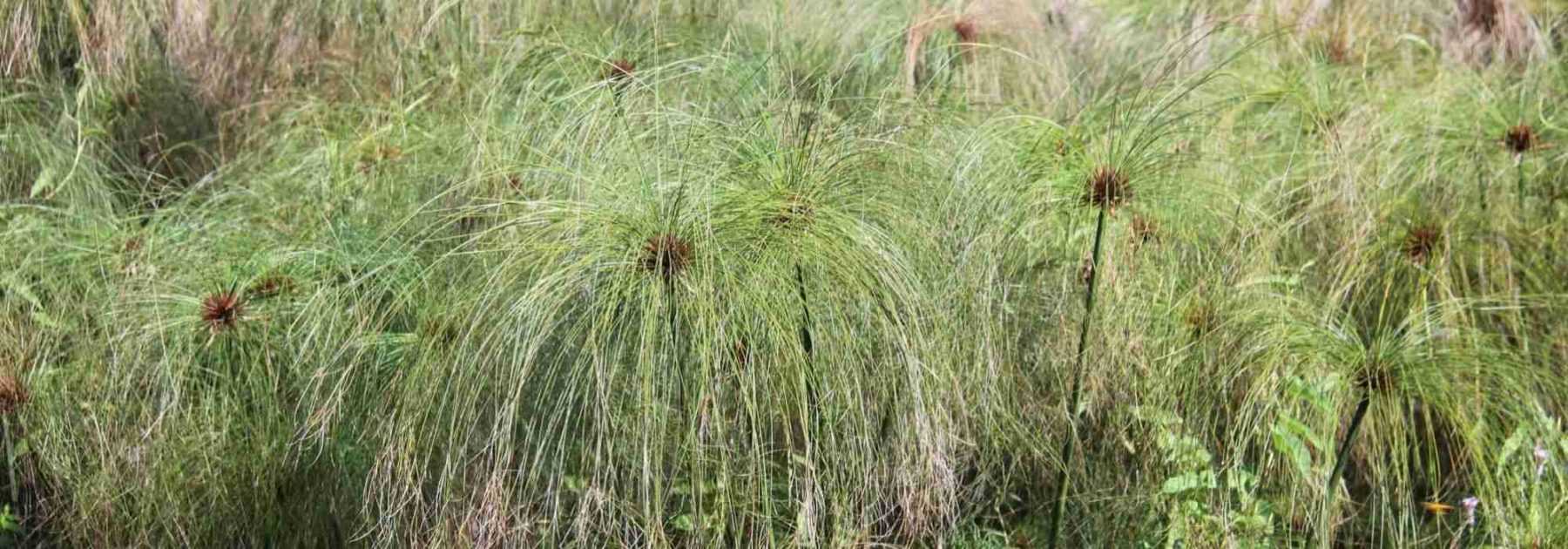
Papyrus, Cyperus: Planting and Care
Contents
The Cyperus, in a few words
- Papyrus or Umbrella Plants are entirely green moisture-loving perennials with a graphic style, forming stiff clumps topped with radiant flower heads.
- Easy to grow in outdoor ponds or containers, some species like the Nile Papyrus and Cyperus alternifolius must however be brought indoors for winter protection in most French regions.
- Other species such as Cyperus glaber and Cyperus longus are exotic-style plants – admittedly less spectacular but fully hardy – suitable for all situations, whether on a balcony, indoors or by a pond.
Our expert's word
Papyrus, also known as Paper Reed, evokes for most people the earliest paper supports invented by the Egyptians, which have been preserved to this day. The pith, cut into fine woven strips, forms the basis of this highly durable paper. The plant bearing the scientific name Cyperus papyrus appears repeatedly in stylised form in Egyptian paintings, much like the Lotus, symbolising Lower and Upper Egypt respectively, and beyond that, the Nile, the lifeblood of this civilisation living on the margin of the desert. The Nile Delta is home to very few papyrus plants today, but on the other hand, it is increasingly used in aquatic gardens, well-watered flower beds, and even in seasonal flower arrangements that adorn our cities in summer.
The spectacular effect of Nile papyrus undoubtedly makes it the most majestic of aquatic plants in mild climates, as it suffers from the first frosts and disappears if the temperature drops below -3°C. It can also be kept fairly easily indoors in a pot placed on a deep saucer constantly filled with water, or as a houseplant in a bathroom, or even grown as an annual. Simply provide this light- and heat-loving Papyrus with a very sunny spot and a sheltered location for winter.
Indoors, the graphic effect is guaranteed even in winter if you have a conservatory or a spot behind a south- or southwest-facing bay window. The plant can also overwinter in a frost-free greenhouse. Its feathery umbels remain unfurled, perched at 2m in height or much less for cultivars selected for floral arrangements. Papyrus plants are entirely green from the base to the inflorescences, even though the tiny flowers sparkle with a soft yellow amidst the thread-like bracts. When the inflorescence dries, the stem dies and new shoots emerging from the stump replace it while the clump expands.
Medium-sized species such as Cyperus glaber, Cyperus longus are hardy and can decorate pond banks alongside native marginal plants like Bulrush or Purple Loosestrife, or exotic plants such as Pickerel Weed, Gunnera, and Thalia dealbata.
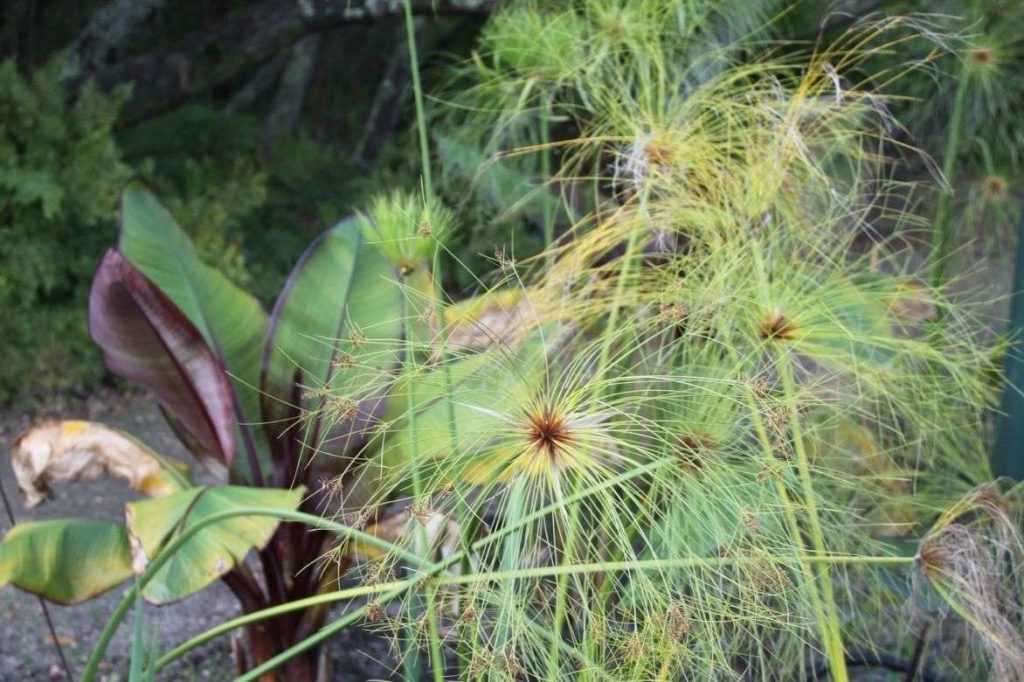
Cyperus papyrus
Description and botany
Botanical data
- Latin name Cyperus
- Family Cyperaceae
- Common name Papyrus, galingale
- Flowering between May and October
- Height between 0.50 and 3 m
- Sun exposure full sun to partial shade
- Soil type any rich, moist to waterlogged soil, even calcareous
- Hardiness Good (-15°C) to low (-3°C)
The Cyperus genus comprises over 600 species found in nearly all the world’s wetland habitats except the coldest. These may be annuals or evergreen perennials, including some highly troublesome adventives in agriculture and horticulture like Cyperus rotundus, native to India and extremely invasive. The most spectacular species for its height and inflorescence size remains Cyperus papyrus, a symbol of rebirth in ancient Egypt and the Lower Egypt region corresponding to the marshy Nile Delta. New, more compact cultivars like ‘Cleopatra’ and ‘Akhenaton’ have the advantage of being less prone to wind damage and are better suited to container growing.
The Cyperus gave their name to their family: the Cyperaceae. They form large clumps of thick, cylindrical or triangular stems – up to 3 cm wide at the base in Cyperus papyrus – reaching variable heights from 1.50 to 5 m tall in the Egyptian Papyrus (Cyperus papyrus). The stems bear narrow, gramineous leaves emerging from the base as in Cyperus albostriatus or are completely leafless like the Nile papyrus. Some species are deciduous, disappearing in winter like Cyperus longus or glaber, while others such as C. alternifolius and C. papyrus persist if temperatures remain mild. In the latter, the plant has no leaves but displays enormous clusters of very fine bracts at the top of its canes, forming a feathery spherical shape. Cyperus plants have rootstocks that allow fairly rapid spread and facilitate propagation. All their aerial parts contain chlorophyll, compensating for the absence of leaves when this occurs.
The highly decorative inflorescences form umbels that are flat (in whorls) or spherical with bracts, reaching up to 25 cm in diameter. These bracts are thread-like in the Nile Papyrus while forming blades 0.5 to 1 cm wide in Cyperus involucratus (syn. alternifolius) or albostriatus. Delicate, feathery spikes, yellowish or pale green, consisting of rather insignificant hermaphrodite flowers, emerge from the centre of the umbel and make the glossy deep green of the bracts shimmer.
At ripeness, the flowers turn brown during summer, releasing wind-dispersed seeds. The Nile Papyrus reproduces both by seed dispersal and vegetatively, through lateral growth of its rootstocks in the mud, forming dense thickets along banks that can grow up to 5 m high – obstacles only large animals like hippopotamuses can cross. Today, this iconic species has virtually disappeared from the Nile Delta due to flood control and the many infrastructures along the river (dams and bank development). Species with flat umbels, meanwhile, produce roots from their “heads” as soon as these come into contact with water.
Cyperus are very easy plants to grow indoors, with the added benefit of purifying the air in our confined spaces. They also help humidify dry indoor air in heated rooms.
Read also
Taking a cutting from a papyrus plantThe main varieties of Papyrus
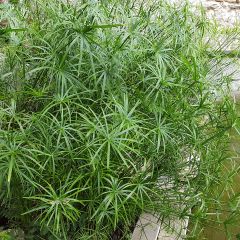
Cyperus alternifolius - Umbrella Papyrus
- Flowering time May, June
- Height at maturity 1 m
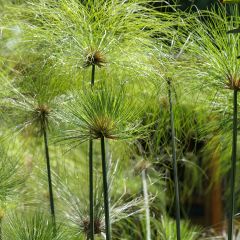
Cyperus papyrus - Papyrus
- Flowering time June, July
- Height at maturity 2 m
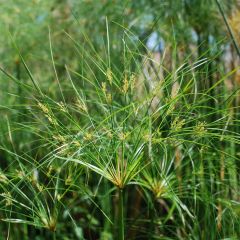
Cyperus papyrus Cleopatra - Papyrus
- Flowering time July, August
- Height at maturity 50 cm
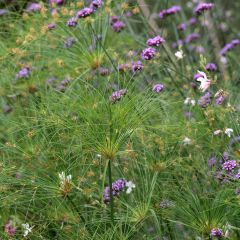
Cyperus papyrus Akhenaton
- Flowering time July to October
- Height at maturity 70 cm
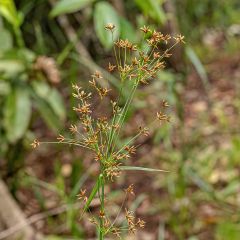
Cyperus longus
- Flowering time August to October
- Height at maturity 80 cm
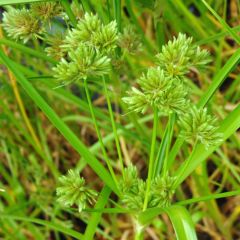
Cyperus glaber
- Flowering time August to October
- Height at maturity 60 cm
Discover other Cyperus
View all →Available in 2 sizes
Available in 1 sizes
Available in 2 sizes

Available in 1 sizes
Available in 1 sizes
Available in 1 sizes
Available in 1 sizes
Available in 2 sizes

Available in 1 sizes
Available in 1 sizes
Planting
Where to Plant Papyrus?
Plant Cyperus preferably in a very sunny spot. Their growth will be slower in partial shade. Opt for planting on the edges of a water feature to ensure constant moisture for the roots. All types of fairly rich soils suit them.
For Cyperus papyrus (Egyptian Papyrus) and alternifolius (Umbrella Plant), the submerged stump can survive if temperatures don’t drop too low in winter (-6 to -8°C if the soil is well-drained for C. alternifolius), and the plant will regenerate the following spring. In regions far from the coast, it’s essential to grow them in pots so they can be brought indoors before the first frosts in a bright room. The Umbrella Plant tolerates the dry indoor atmosphere better than Egyptian Papyrus. The species glaber and longus can withstand temperatures as low as -15°C without issue.
→ Learn more about growing Papyrus in pots
When to Plant?
- Spring is the best time to plant your papyrus outdoors.
- Wait until the last frosts have passed before moving the pot outside.
How to Plant?
To plant in a pot, create a mix of compost and garden soil, ideally clay or loam.
Choose a container wide enough to accommodate the rapid spread of the clump during the season.
Don’t bury the root ball deeper than it was in its original pot, but you can adjust the water level by fully submerging the pot with 5 to 10 cm of water above it or simply keeping the base of the container in water.
If you don’t submerge the pot in a pond, place a deep saucer constantly filled with water beneath the pot.
- Be cautious when exposing a plant that has been in a greenhouse or indoors. Gradually acclimatise it to avoid scorching the foliage after winter.
- Divide your papyrus when it becomes too large and share the young plants with friends and neighbours.
- Watch out for whiteflies or red spider mites indoors. These parasitic pests thrive in dry, warm conditions.
- In open ground, prepare the soil thoroughly over at least 50 cm in diameter.
- Enrich your soil if it’s poor by adding compost or well-rotted manure.
- Mulch generously with gravel or grass clippings to retain moisture.
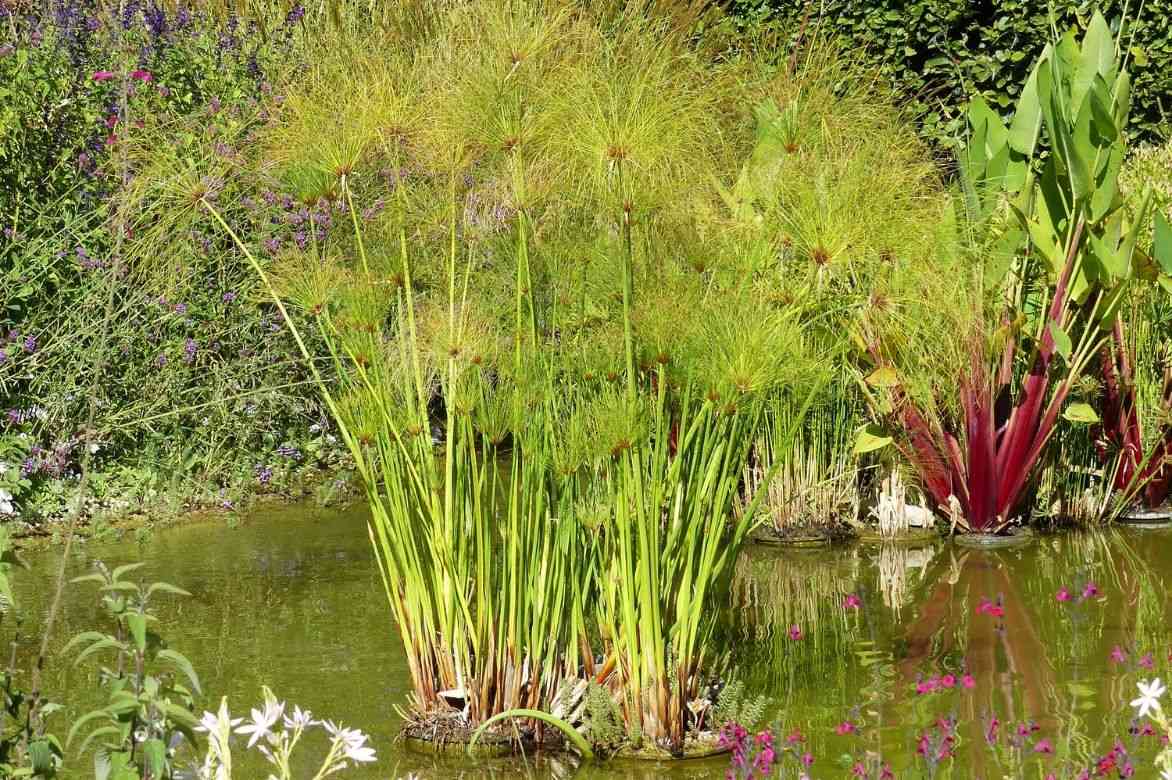
Maintenance
- Ensure the soil remains consistently moist without allowing water to stagnate in the saucer.
- From April to the end of September, feed plants placed on a terrace or indoors with a liquid houseplant fertiliser twice a month.
- Cut back dry stems in November or before new growth begins.
- Bring the plant indoors or cover the stump with a thick layer of mulch, depending on the species’ cold tolerance.
Propagation: dividing, taking a cutting from papyrus
Dividing the stump between spring and summer is the simplest way to propagate papyrus plants. You can also take cuttings from the tips of stems from cyperus species other than the Nile papyrus.
Propagation by cuttings from shoot tips
- Cut shoot tips with a 10 cm section of stem.
- Let these shoot tips float upside down in water until roots appear.
- Then plant the rooted cuttings in soil. A new shoot will form.
→ Learn more in our tutorial: Propagating papyrus by cuttings
Dividing the stump
- Remove the root ball from its pot.
- Separate a portion of the root ball or just a stem with a piece of rootstock.
- Replant immediately in soil.
→ Learn more in our tutorial How to divide a papyrus or Cyperus plant?
Uses and Associations
Papyrus, a wonderful waterside plant for very mild climates, is also a stunning species for patios, relatively easy to grow provided the soil remains consistently moist. It will work wonders around a small above-ground pond on a terrace, for example, alongside Rhodocoma gigantea, a magnificent large restio, as well as Japanese maples for semi-shaded spots or agapanthus in full sun. These lush perennials will captivate enthusiasts of striking plants with their bamboolike silhouette, forming monumental sprays of large feathery plumes. Majestic when planted alone, their combination in borders or containers with cannas featuring purple or green foliage, bamboos, Nandinas, Dieramas or angel’s fishing rods, persicarias, or even a Gomphostigma virgatum will create a breathtaking scene.
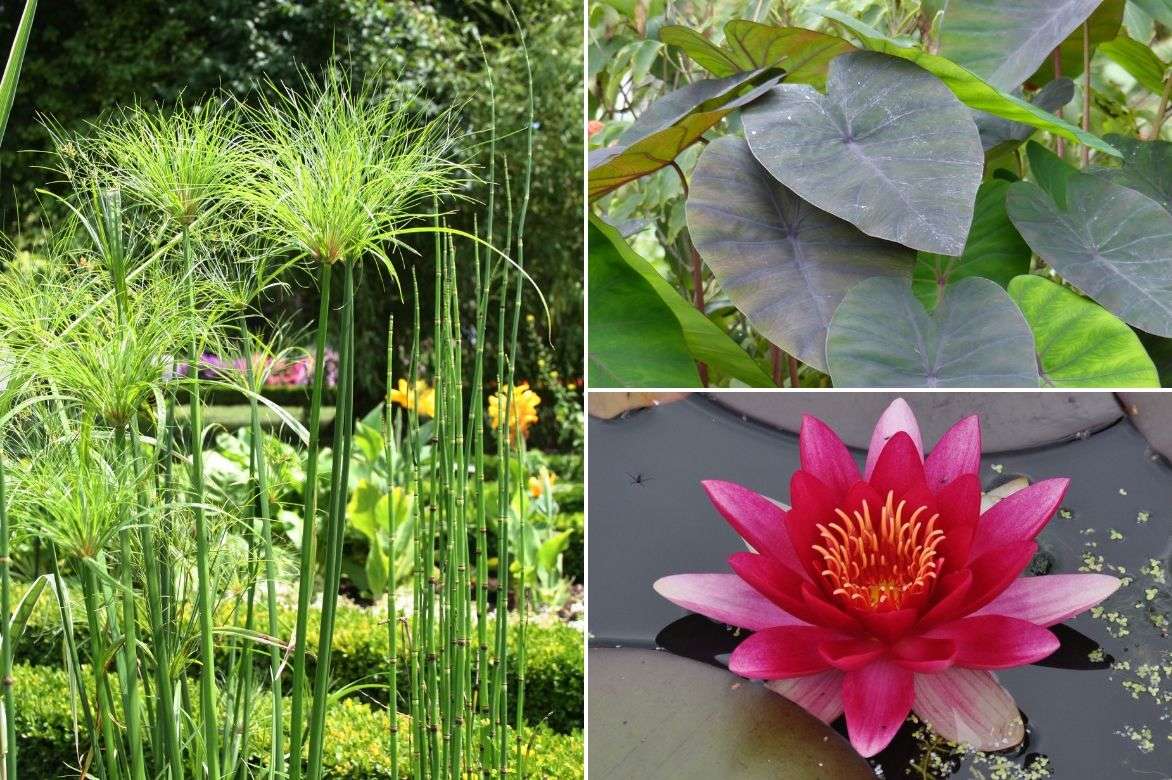

An idea for a combination in a large half-barrel or small pond: Cyperus papyrus (‘Akhenaton’ or ‘Cleopatra’), Colocasia madeira and Nymphea ‘Attraction’
The Eurasian species Cyperus longus or Sweet Galingale is well-suited to ponds and lakes, providing shelter and nesting sites for wild pheasants, moorhens, and passing ducks. It spreads quite quickly via short rootstocks and can cover an area of 2–3 m² in no time. It is therefore best reserved for large, wild-style gardens, where it will add a beautiful orange glow in autumn. The advantage is that its dense foliage smothers all weeds.
Small ponds can accommodate Cyperus glaber or alternifolius, if the climate allows, for their graphic effect, which pairs well with Japanese horsetails as well as waterside perennials such as Virginia spiderwort, astilbes or primroses, or even stream sedges. These two sedges, with their upright form and rigid stems, are also prized in large pots to adorn a terrace or flank staircase steps.
→ Discover more ideas for combining Cyperus papyrus in our advice sheet!
To go further
- Discover our range of Papyrus
- Care guide: Overwintering a Cyperus
Frequently asked questions
-
How to overwinter papyrus?
Place the pot in a very sunny location, with little or no heating. If you're growing Papyrus indoors, it can sometimes be helpful to mist its foliage occasionally, due to the often overly dry atmosphere in our homes. During the warmer months, from April-May to October, your potted Papyrus can take pride of place on the terrace or balcony, in full sun, by gradually acclimatising it to the sun's rays.
- Subscribe!
- Contents
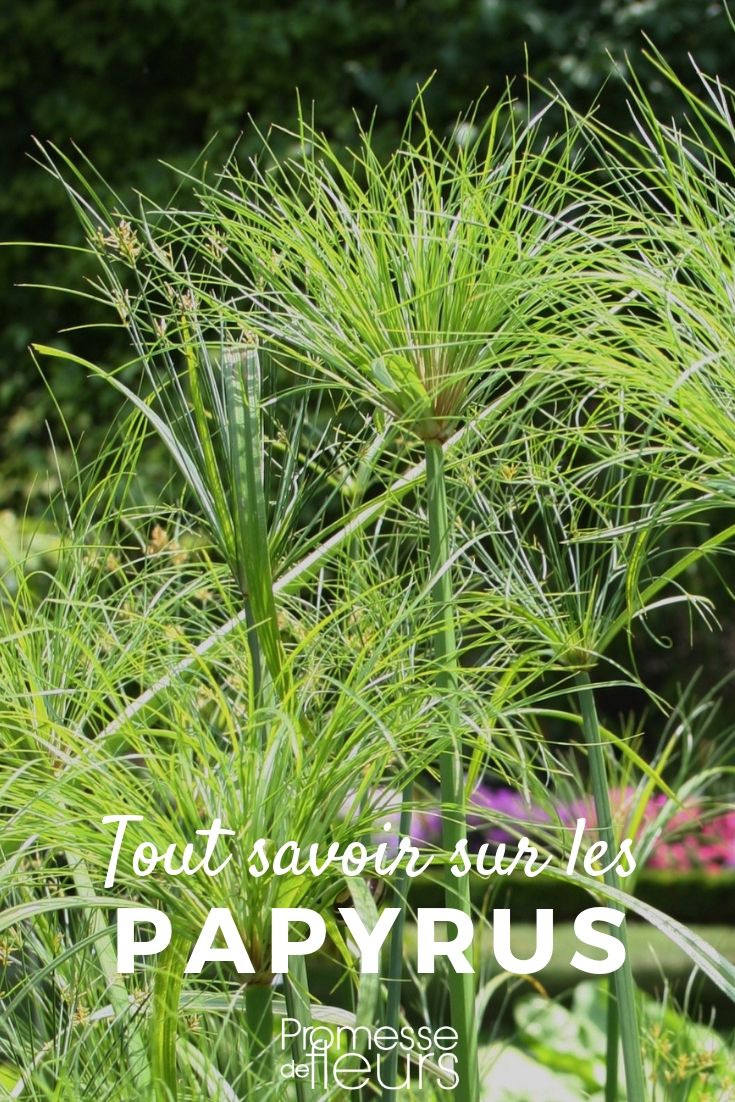



































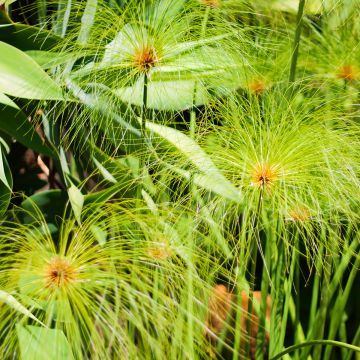

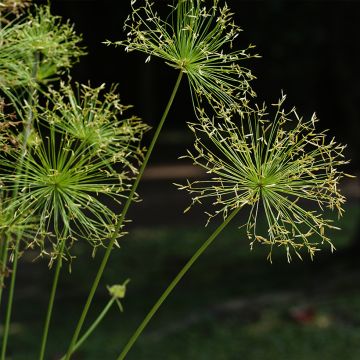

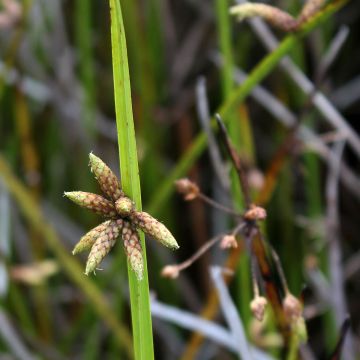

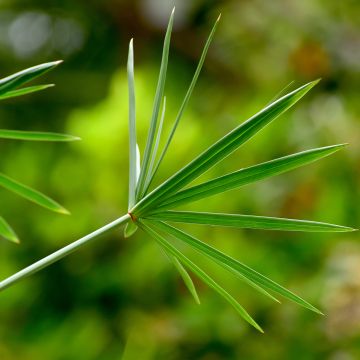
Comments